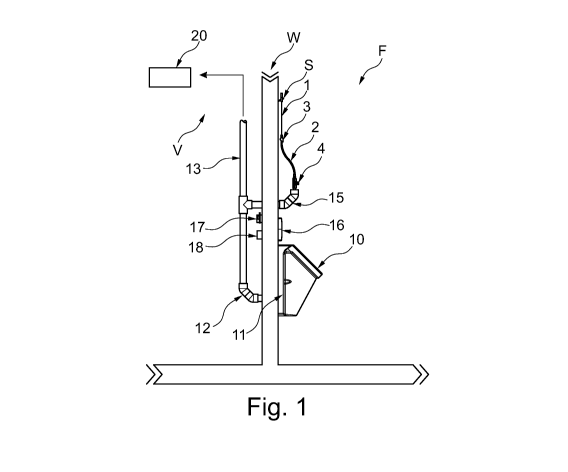Some of the information on this Web page has been provided by external sources. The Government of Canada is not responsible for the accuracy, reliability or currency of the information supplied by external sources. Users wishing to rely upon this information should consult directly with the source of the information. Content provided by external sources is not subject to official languages, privacy and accessibility requirements.
Any discrepancies in the text and image of the Claims and Abstract are due to differing posting times. Text of the Claims and Abstract are posted:
| (12) Patent Application: | (11) CA 3032760 |
|---|---|
| (54) English Title: | METHOD AND INSTALLATION FOR HANDLING MEDICAL WASTE COLLECTED IN A RECEPTACLE FOR MEDICAL WASTE, CATHERTER BAG FOR USE IN SUCH AN INSTALLATION AND MEDICAL WASTE MANAGEMENT SYSTEM |
| (54) French Title: | PROCEDE ET INSTALLATION DE MANIPULATION DE DECHETS MEDICAUX COLLECTES DANS UN RECEPTACLE POUR DECHETS MEDICAUX, POCHE DE CATHETER DESTINEE A ETRE UTILISEE DANS UNE TELLE INSTALLAT ION ET SYSTEME DE GESTION DE DECHETS MEDICAUX |
| Status: | Examination Requested |
| (51) International Patent Classification (IPC): |
|
|---|---|
| (72) Inventors : |
|
| (73) Owners : |
|
| (71) Applicants : |
|
| (74) Agent: | ROBIC AGENCE PI S.E.C./ROBIC IP AGENCY LP |
| (74) Associate agent: | |
| (45) Issued: | |
| (86) PCT Filing Date: | 2017-08-17 |
| (87) Open to Public Inspection: | 2018-02-22 |
| Examination requested: | 2022-07-13 |
| Availability of licence: | N/A |
| (25) Language of filing: | English |
| Patent Cooperation Treaty (PCT): | Yes |
|---|---|
| (86) PCT Filing Number: | PCT/FI2017/050578 |
| (87) International Publication Number: | WO2018/033664 |
| (85) National Entry: | 2019-02-01 |
| (30) Application Priority Data: | ||||||
|---|---|---|---|---|---|---|
|
The present invention relates to a method and installation for handling medical waste, bio-waste, or other corresponding contaminated waste, which is collected in a receptacle for medical waste. For an isolated treatment of the waste, the method employs a vacuum waste system (V), whereby medical waste is collected in the receptacle for medical waste, medical waste is discharged from the receptacle for medical waste into a waste fixture connected to a vacuum waste piping (13) of the vacuum waste system (V). The discharge sequence of the vacuum waste system is activated by an activating means for discharge of the medical waste from the waste fixture or the vacuum waste piping (13) of the vacuum waste system (V) to a waste collecting unit (20) of the vacuum waste system.
La présente invention concerne un procédé et une installation de manipulation de déchets médicaux, de déchets biologiques ou d'autres déchets contaminés correspondants, qui sont collectés dans un réceptacle pour déchets médicaux. Pour un traitement isolé des déchets, le procédé utilise un système de déchets sous vide (V), les déchets médicaux étant collectés dans le réceptacle pour déchets médicaux, puis évacués du réceptacle dans une installation sanitaire de déchets reliée à une tuyauterie de déchets sous vide (13) du système de déchets sous vide (V). La séquence d'évacuation du système de déchets sous vide est activée par un moyen d'activation pour évacuer les déchets médicaux à partir de l'appareil d'installation sanitaire de déchets ou de la tuyauterie de déchets sous vide (13) du système (V) vers une unité de collecte de déchets (20) du système (V).
Note: Claims are shown in the official language in which they were submitted.
Note: Descriptions are shown in the official language in which they were submitted.

For a clearer understanding of the status of the application/patent presented on this page, the site Disclaimer , as well as the definitions for Patent , Administrative Status , Maintenance Fee and Payment History should be consulted.
| Title | Date |
|---|---|
| Forecasted Issue Date | Unavailable |
| (86) PCT Filing Date | 2017-08-17 |
| (87) PCT Publication Date | 2018-02-22 |
| (85) National Entry | 2019-02-01 |
| Examination Requested | 2022-07-13 |
There is no abandonment history.
Last Payment of $210.51 was received on 2023-08-03
Upcoming maintenance fee amounts
| Description | Date | Amount |
|---|---|---|
| Next Payment if small entity fee | 2024-08-19 | $100.00 |
| Next Payment if standard fee | 2024-08-19 | $277.00 |
Note : If the full payment has not been received on or before the date indicated, a further fee may be required which may be one of the following
Patent fees are adjusted on the 1st of January every year. The amounts above are the current amounts if received by December 31 of the current year.
Please refer to the CIPO
Patent Fees
web page to see all current fee amounts.
| Fee Type | Anniversary Year | Due Date | Amount Paid | Paid Date |
|---|---|---|---|---|
| Application Fee | $400.00 | 2019-02-01 | ||
| Maintenance Fee - Application - New Act | 2 | 2019-08-19 | $100.00 | 2019-07-17 |
| Maintenance Fee - Application - New Act | 3 | 2020-08-17 | $100.00 | 2020-08-04 |
| Maintenance Fee - Application - New Act | 4 | 2021-08-17 | $100.00 | 2021-07-09 |
| Request for Examination | 2022-08-17 | $814.37 | 2022-07-13 | |
| Maintenance Fee - Application - New Act | 5 | 2022-08-17 | $203.59 | 2022-07-15 |
| Maintenance Fee - Application - New Act | 6 | 2023-08-17 | $210.51 | 2023-08-03 |
Note: Records showing the ownership history in alphabetical order.
| Current Owners on Record |
|---|
| EVAC OY |
| Past Owners on Record |
|---|
| None |